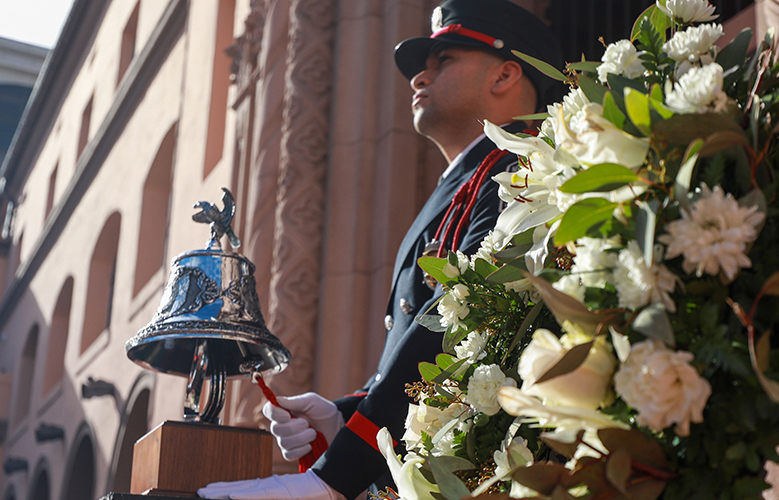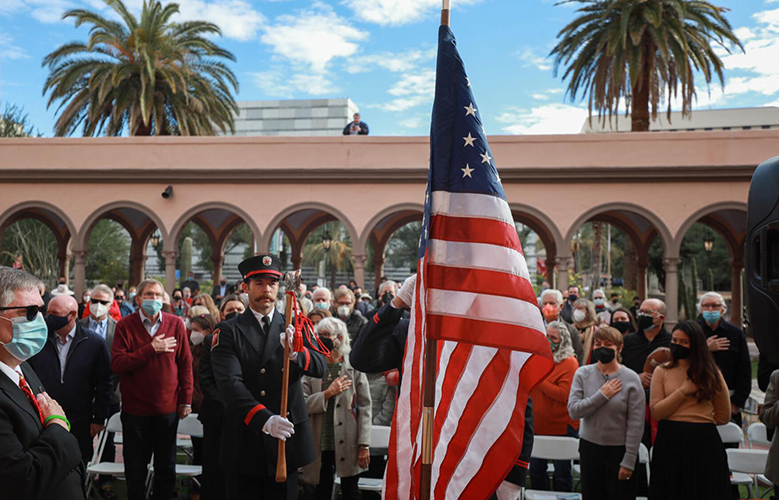
|
Chief Judge John M. Roll RememberedFebruary 28, 2022
On the 10th anniversary of the deadly 2011 shooting near Tucson, Arizona, the January 8 Memorial, titled “The Embrace,” dedicated to the victims, including then-Chief Judge John M. Roll of the United States District Court for the District of Arizona, opened. The 2021 event honored the 18 victims; six were killed, 12 badly wounded, including then-U.S. Representative Gabby Giffords. Judge Roll served the U.S. legal system with distinction for nearly 20 years prior to his appointment as district judge on the U.S. District Court for the District of Arizona, where he served for 20 more years, becoming chief judge in 2006. He wrote 850 opinions in his career. The January 8 Memorial Foundation was established by a group of survivors, family members and community leaders to remember and honor those who died or were injured during the assassination attempt on Rep. Giffords. Following input from the above groups, along with first responders, medical personnel and the public, the memorial, located at the Old Pima County Courthouse in downtown Tucson, was dedicated in 2018, though not completed until 2021. It was described by writer Henry Brean in his 2021 Arizona Daily Star article: “The newly finished memorial is nestled along the west side of the historic Pima County Courthouse, where almost an acre of gardens and paths surround a pair of curved steel walls separated by matching pools. “The names of those killed and wounded in the mass shooting 10 years ago today are carved into the pools’ concrete walls. Their stories are told with modern-day petroglyphs, cut from the steel panels — a judge’s gavel, a little girl’s butterfly, a Capitol dome for a congresswoman.”1 The shooting took place at a supermarket parking lot in Casas Adobes, Arizona, near Tucson, where Rep. Giffords was holding a constituent meeting. Judge Roll was attending the event to thank her for supporting his petition to declare a judicial emergency and her assistance in securing funding for the new federal courthouse in Yuma. The assailant opened fire without warning. Rep. Giffords was shot through the head but survived the attack. The shooter was sentenced to life in prison in November 2012. In a spontaneous outpouring of grief and sympathy, flags on scores if not hundreds of courthouses and government buildings around the country, including the White House and the United States Supreme Court, flew at half-mast for the next few days. Judge Roll was 63 years old. He is survived by his wife, a brother, three sons and five grandchildren. His funeral drew more than 1,700 mourners, many of them colleagues from the federal and state benches. In August 2011, the annual Ninth Circuit Judicial Conference opened with a touching tribute to Judge Roll, which his widow, Maureen, attended. A special session was convened Jan. 6, 2012, by judges of the U.S. District Court for the District of Arizona to observe the first anniversary of Judge Roll’s death. Then-Chief Judge of the Ninth Circuit Court of Appeals Alex Kozinski had worked closely with Judge Roll to develop resources for the Arizona court. “I can say without qualification that no one worked harder on behalf of the court and, by extension, the people of Arizona, than him,” Judge Kozinski wrote at the time. “Judge Roll was always on the job, striving to make things better for his district, for the circuit or for his family and community.” Another project in which Judge Roll was deeply invested was the building of a new courthouse in Yuma, later named in his honor as The John M. Roll United States Courthouse, which opened for occupancy in late 2013. The two-story, 56,800-square-foot courthouse houses two courtrooms, jury rooms and judges’ chambers along with space for offices of the bankruptcy and district courts, probation and pretrial services, and the U.S. Marshals Service. It was built at a cost of $33.4 million on a prominent site along the Colorado River, near Yuma’s major state and local government buildings. Designed “green,” the courthouse makes extensive use of solar power and locally-obtained Arizona sandstone was used in the building, which features a two-story glass lobby. Judge Roll was honored by a number of fellow members of the judiciary. U.S. Supreme Court Chief Justice John G. Roberts, Jr., said “Chief Judge John Roll was a wise jurist who selflessly served Arizona and the nation with great distinction, as attorney and judge, for more than 35 years.”2 In a Los Angeles Times article dated March, 2014, Ninth Circuit Chief Judge Emeritus Mary M. Schroeder (2000-2007) of Phoenix, said Judge Roll was “famous for being able to say so many genuinely nice things about people without having to consult notes, for he so genuinely loved people and had such a remarkable mind.”3 In a moving personal tribute to Judge Roll, Senior District Judge James A. Teilborg, of the U.S. District Court for the District of Arizona said, “I came to understand the breadth and depth of his character and integrity. Though he held strong, principled views on a variety of subjects, his decision-making process always centered on finding the right and just answer. I never sensed he let ideology drive a result. As Chief Judge, he filled some big shoes of outstanding predecessors. He quickly rose to the occasion. He was unafraid to make difficult or even unpopular decisions, but only did so after seeking as much input as possible and attempting to build a consensus. I believe leadership is fundamentally unselfish and John personified that principle.”4 U.S. Marshal David Gonzales was interviewed on the WakeUp! Tucson (KVOI) radio program two days after the shooting. “For someone in his position and stature and background he was the most down to earth person that you ever met,” said Gonzales. “He was a friend to everybody. He was a great judge and a good person. Regardless of what he did for a living, you look at a person for how they treat other people, and whether it was the man on the street, or a stranger he met, he was always just the kindest person. He was a great family man; he was very religious and followed those principles.”5 “Judge Roll was as fine a man, husband, father and community member as he was a judge,” said Chief Judge Murray Snow, U.S. District Court for the District of Arizona, a long-time friend of Judge Roll. “He knew, liked, and reached out in kindness to everyone. In the last conversation I had with him he remarked how unfortunate it would be if someone valued being a judge more than all of the other pursuits that bring meaning to life. In that sense, the memorial, which does note his great contributions as a judge, also symbolizes those other aspects of who he was that made him the person we all valued for much more than just his judicial talents alone.” Nominated by President George H. W. Bush on Sept. 23, 1991, Judge Roll was confirmed by the U.S. Senate on Nov. 22, 1991, to serve as a district judge on the U.S. District Court for the District of Arizona and received his judicial commission on November 25. He was elevated to chief judge of his court on May 1, 2006, and served until his death on Jan. 8, 2011. Education: University of Arizona, B.A., 1965-69; University of Arizona College of Law (now James E. Rogers College of Law), J.D., 1969-72; University of Virginia School of Law, LL.M., 1990 Career Record:
|
||||







